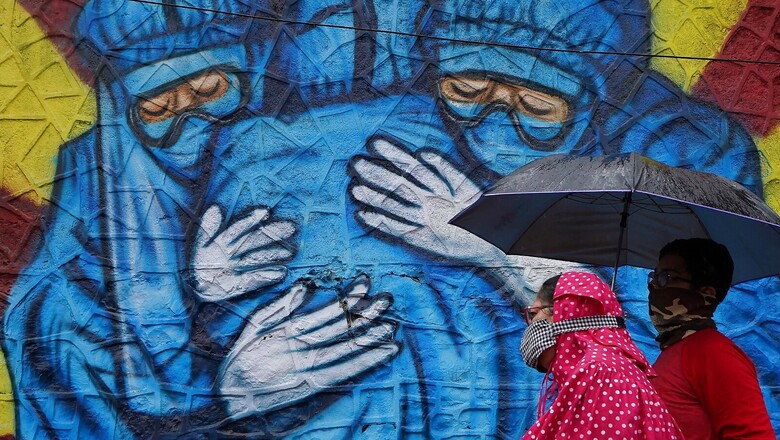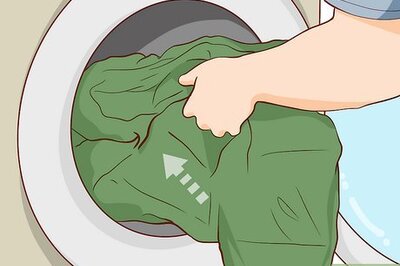
views
The last two years have been transformative for many of us. We have confronted and processed unexpected realities that we were not primed or trained to navigate. If you ask for “key words” that sum up my last two years, they would look be “adaptability, elasticity, flexibility, acceptance”. As an immigrant scientist of Indian origin living in the United States, throughout this pandemic, I shuttled between two countries that lead the world’s tally in terms of COVID-19 related deaths. With elderly parents in India and my own roots and work in the US, my life rode with the virus curves in these two countries. Unfortunately, the two virus curves were not synchronous, when one went up the other went down, which implied I almost always felt a sense of continuous anxiety. As I write this article, the US’s astronomic case trajectory from the Omicron wave is showing some signs of slowing down, while India’s is rising sharply. How long can we sustain this battle against COVID, when will this be finally over?
Unfortunately, believing that the pandemic is going to be over with a sweeping Omicron wave is wishful thinking. For this rapidly mutating virus, somewhere out there, there is a human petri dish that is generating another variant which will cause the next wave. I have come to terms with the fact that protective herd immunity is probably not achievable with SARS-CoV-2. We must get the whole world vaccinated at a target of 70-80 per cent to have a reasonable sense of normalcy in any country. Till then, we will be in this seesaw modality of life with the variants versus boosters duel continuing in a periodic manner.
And when waves arrive, we will need mitigation strategies layered over the immunity quilt of a population. The immunity quilt is defined through hybrid immunity induced by past infections and vaccines and varies across geography. I write with this acceptance and a recognition that we are all very tired and burnt out due to this pandemic, but the pandemic will likely continue in 2022. I have focused so far on writing about prediction and mitigation strategies for COVID-19 infections and fatalities for the past two years. Today I am writing about living your life with COVID in 2022 in a safe and pragmatic way, and share some tips both as a scientist and as a human being.
1. The hallmark of this pandemic is polarisation of opinions. But there is an alternative to being cavalier and saying COVID is nothing or being panic-driven and saying COVID is cataclysmic and end of the world. Follow the middle road, choose prudence over panic.
2. Despite the Omicron despair, we are in a much better place now than two years ago. The vaccines are keeping people out of the hospitals, ICUs. Do everything possible to stay on schedule with respect to vaccination/booster doses and promote that awareness in your immediate social circle.
3. Demand data from public health officials in your state or community that impacts your own health. For example, as receivers of vaccines, you have a right to know about the vaccine effectiveness, rate of breakthrough infections, hospitalisations, ICU admissions for the vaccine regime you received. Is there evidence of waning immunity? After how many months since the second dose do you see a decline in antibodies? Which vaccine is a better choice for your booster?
4. Be mentally prepared to change your plans if the virus curve shows a surge. One large event with a transmissible virus like Omicron can lead to thousands of cases downstream. If all of us as individuals are engaging in maximal risk-taking behaviour, the collective risk is monumental. There is a spillover effect here where your action and exposure can determine outcomes of others. We need to appreciate both individual-level risk and collective risk. This adaptability and flexibility are going to be incredibly important as we navigate 2022. As a statistician, I am very comfortable with modeling such uncertainties but not when it comes to planning my life. But I have gradually accepted and tried to swim along the tide of uncertainty.
5. Gainfully use the tools that have been developed to battle the pandemic. For example, rapid antigen home tests can tell one if they are infectious or not, even when they are not experiencing any symptoms. Right before meeting people beyond your immediate circle or people who are vulnerable, or boarding a flight or attending a wedding, take the test. If you turn positive, isolate.
6. Get comfortable with the idea that getting COVID is not a stigma or a moral failure. The number of people in our social circle who have had COVID will soon exceed those who have not. No one is an exception, and we will most likely get it at some point in time. Vaccines/boosters will help us from falling critically ill. It is natural to feel defeated on contracting COVID after fighting it for two years but remember you are an armed soldier now. You can endure some wounds, but vaccines are your protecting shield and will prevent you from dying. There are new anti-viral treatments that appear to be safe and effective. We must be cautious when there is a virus in active circulation in the community so that not all of us fall sick at the same time, but some of us will, even with all the necessary precaution. Prepare for the inevitable.
7. What is “mild disease” for someone could be a death warrant for others. So instead of making such blanket statements that do not recognise the value of life for the vulnerable, respect COVID as a disease and a significant concern. Recognising elevated stress and anxiety in others and modulating your own behaviour accordingly could go a long way in bringing us together.
8. If you or your loved ones have had COVID, watch out for long COVID symptoms and seek medical advice if something feels unusual in the post-COVID phase. Do not neglect or procrastinate.
9. None of us want to keep wearing masks. But even with vaccination, proper usage of high-quality masks is a must when you are in indoor large gatherings with people whose vaccination status you do not know or there is a new virus strain in active circulation. Till the world reaches the vaccine versus variant equilibrium, err on the side of caution.
10. Our focus should shift towards continuing life safely instead of considering perpetual remote work or education as a strategy and go to lockdowns when there is a surge. We need our children to go to school, we need to see our friends, we need to travel to destinations longed for, we need to be able to enjoy live performing arts again. We can gradually resume these valuable activities with vaccines, masks, rapid tests, using outside areas innovatively, re-thinking ventilation of used spaces. And we all must dial down when there is an active surge. It is important to use the valleys of the virus curve to do things we enjoy as our soul and our mind also need nourishment and healing. Mental health and holistic well-being should not be neglected. The cost of COVID is not just COVID. We must mitigate both costs, not just wear ourselves out to fight COVID.
The Omicron wave is probably going to sweep through the country quickly without much human casualty (we expect deaths to be half or one third of the second wave even as infections soar, thanks to vaccines). It will still cause a stress on families and healthcare systems with many people falling sick. As we resurface from this wave, we must remember the lessons and strategies that helped each of us, towards building a pandemic-resilient future. We must also create a community level acceptance which allows us to be sad, to mourn the loss, to grieve, and be vulnerable. We have experienced a generational trauma by going through this global pandemic together, we need to recognise that. I hope we emerge out of this pandemic with fresh values and fortified valour. If one thing the pandemic has taught us, it is what is truly important and irreplaceable in life and society. I hope these lessons make us better scientists, better people, and better nations.
Bhramar Mukherjee is John D. Kalbfleisch Collegiate Professor of Biostatistics, Chair of Biostatistics; Professor of Epidemiology, Professor of Global Public Health School of Public Health, University of Michigan. She is also Associate Director for Quantitative Data Sciences, University of Michigan Rogel Cancer Centre. She and her team have been modeling the pandemic in India since March 2020. The views expressed in this article and those of the author and do not represent the stand of this publication.
Read all the Latest Opinions here




















Comments
0 comment